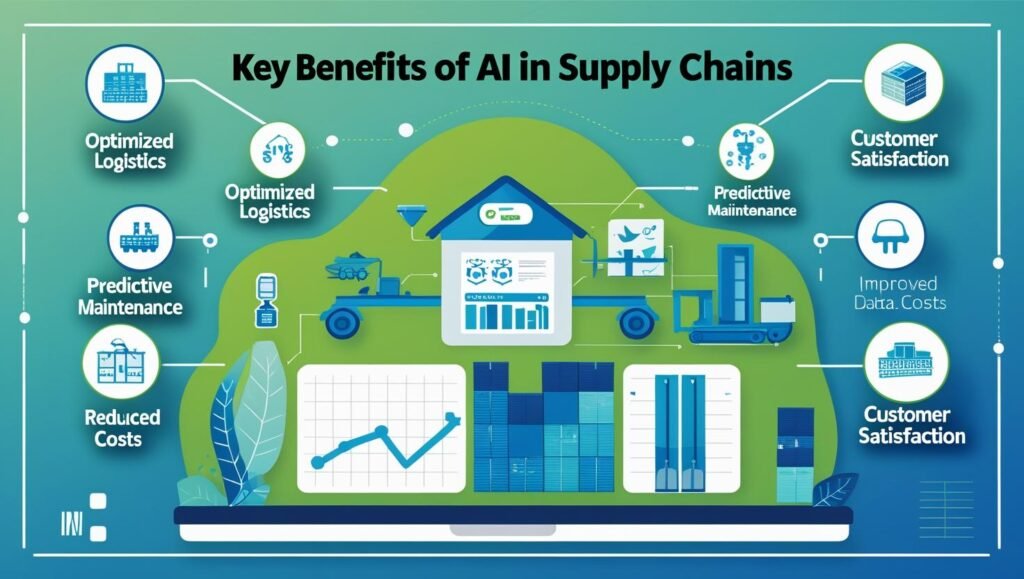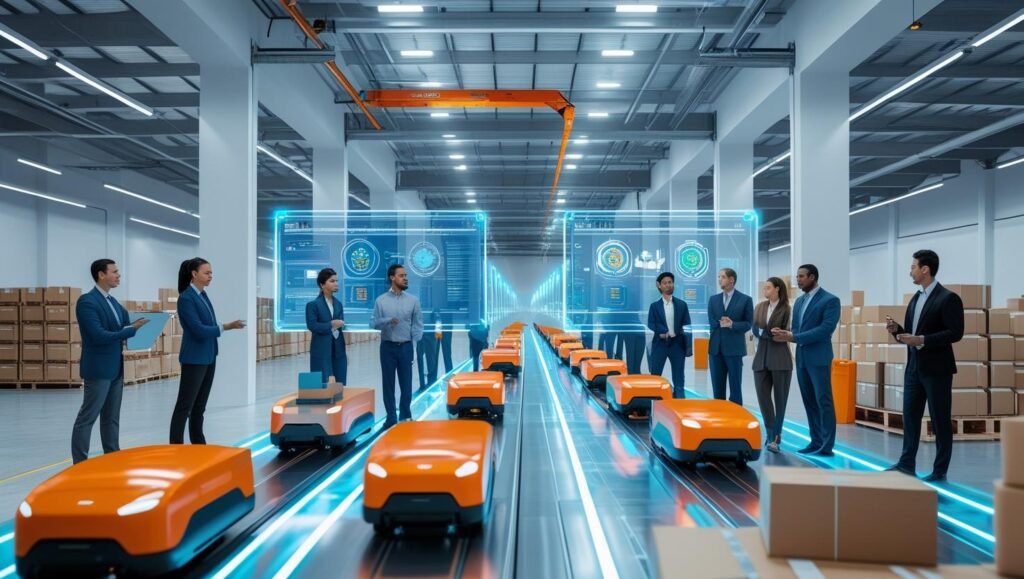AI in Supply Chain Optimization: Boosting Efficiency and Cutting Costs

In today’s fast-paced business landscape, the quest for efficiency and cost reduction has never been more critical. Enter artificial intelligence (AI), a game-changer poised to revolutionize supply chain optimization. By harnessing the power of data and advanced algorithms, AI equips businesses with the tools to streamline operations, predict demand with remarkable accuracy, and enhance overall agility.
Imagine reducing lead times, minimizing waste, and improving customer satisfaction all at once. As organizations increasingly turn to AI-driven solutions, they unlock new levels of operational excellence, transforming the traditional supply chain into a dynamic, responsive network. Join us as we explore how AI not only boosts efficiency but also significantly cuts costs, offering a competitive edge in an ever-evolving market.
Whether you’re a seasoned logistics professional or a curious newcomer, this journey into the synergy of AI and supply chain management is set to inspire fresh insights and innovative solutions.
The Role of AI in Supply Chain Optimization
Artificial Intelligence (AI) has emerged as a powerful tool in the realm of supply chain optimization, fundamentally altering how businesses manage and streamline their operations. One of the primary roles of AI in supply chains is its ability to analyze vast amounts of data quickly and accurately.
Traditional methods of data analysis are often time-consuming and prone to human error, limiting their effectiveness. AI, on the other hand, can process and interpret data at a scale and speed that humans simply cannot match, providing real-time insights that can be used to make informed decisions. This capability allows businesses to identify patterns, predict trends, and respond proactively to changes in the market, leading to more efficient and effective supply chain management.
Another significant role of AI in supply chains is automation. Through the use of machine learning algorithms and robotic process automation (RPA), AI can automate repetitive and mundane tasks that would otherwise require significant human effort. This not only frees up valuable human resources for more strategic activities but also reduces the likelihood of errors and increases overall productivity.
For example, AI can automate inventory management processes, ensuring that stock levels are maintained optimally without the need for constant manual intervention. This leads to reduced inventory holding costs and minimizes the risk of stockouts or overstock situations.
AI also plays a crucial role in enhancing supply chain visibility and transparency. With the integration of AI-driven technologies, businesses can gain a comprehensive view of their supply chain operations in real-time. This visibility allows for better tracking of goods and materials as they move through the supply chain, enabling more accurate and timely decision-making.
In addition, AI can help identify potential risks and disruptions in the supply chain, allowing businesses to take proactive measures to mitigate these risks. Overall, the role of AI in supply chain optimization is to provide businesses with the tools and insights they need to operate more efficiently, reduce costs, and improve customer satisfaction.
Key Benefits of Implementing AI in Supply Chains

Implementing AI in supply chains offers a multitude of benefits that can significantly enhance business performance and competitiveness. One of the most notable benefits is improved demand forecasting. Traditional forecasting methods often rely on historical data and simplistic models, which can lead to inaccurate predictions and suboptimal inventory management. AI, however, can analyze a wide range of data sources, including sales trends, market conditions, and even social media activity, to generate highly accurate demand forecasts. This enables businesses to better anticipate customer needs, reduce excess inventory, and ensure that products are available when and where they are needed.
Another key benefit of AI in supply chains is enhanced operational efficiency. By automating routine tasks and optimizing processes, AI can help businesses streamline their operations and reduce waste. For example, AI-powered route optimization algorithms can determine the most efficient delivery routes, minimizing fuel consumption and reducing delivery times. Similarly, AI can optimize production schedules to ensure that manufacturing processes run smoothly and efficiently, reducing downtime and increasing output. These improvements in efficiency can lead to significant cost savings and allow businesses to operate more sustainably.
AI also offers the benefit of improved decision-making. With access to real-time data and advanced analytics, businesses can make more informed and strategic decisions. AI can identify potential issues and opportunities that may not be immediately apparent to human decision-makers, providing valuable insights that can drive better outcomes. For instance, AI can detect early signs of supply chain disruptions, such as supplier delays or transportation bottlenecks, allowing businesses to take proactive measures to address these issues before they escalate. Additionally, AI can help businesses identify and capitalize on new market opportunities, enabling them to stay ahead of the competition.
AI Technologies Transforming Supply Chain Processes
Several AI technologies are transforming supply chain processes, each bringing unique capabilities and advantages. One such technology is machine learning, which enables systems to learn from data and improve their performance over time. In supply chains, machine learning algorithms can be used to optimize inventory management, demand forecasting, and supply chain planning. By continuously analyzing data and adjusting their models, these algorithms can provide increasingly accurate predictions and recommendations, leading to more efficient and effective supply chain operations.
Another transformative AI technology is natural language processing (NLP). NLP allows computers to understand and interpret human language, enabling more intuitive and interactive communication with AI systems. In supply chains, NLP can be used to automate customer service and support, process orders, and manage supplier communications. For example, AI-powered chatbots can handle customer inquiries and provide real-time assistance, reducing the need for human intervention and improving the overall customer experience. NLP can also be used to analyze unstructured data, such as emails and social media posts, to gain insights into customer sentiment and identify potential issues or opportunities.
Computer vision is another AI technology that is making a significant impact on supply chain processes. Computer vision involves the use of cameras and image recognition algorithms to capture and analyze visual information. In supply chains, this technology can be used for a variety of applications, such as quality control, inventory management, and warehouse automation. For example, computer vision systems can inspect products for defects during the manufacturing process, ensuring that only high-quality products reach the market. In warehouses, computer vision can be used to track inventory levels and monitor the movement of goods, improving accuracy and efficiency.
Real-World Examples of AI in Supply Chain Optimization

Numerous real-world examples highlight the transformative impact of AI in supply chain optimization. One notable example is the use of AI by global retail giant Walmart. Walmart has implemented AI-driven demand forecasting algorithms to predict customer demand with remarkable accuracy. By analyzing a vast array of data points, including historical sales data, weather patterns, and local events, Walmart can ensure that its stores are stocked with the right products at the right time. This not only improves customer satisfaction but also reduces inventory holding costs and minimizes waste.
Another compelling example is the use of AI by DHL, a leading logistics company. DHL has integrated AI-powered route optimization algorithms to enhance its delivery operations. These algorithms analyze real-time traffic data, weather conditions, and delivery schedules to determine the most efficient routes for its fleet of delivery vehicles. As a result, DHL has been able to reduce fuel consumption, lower delivery times, and improve overall operational efficiency. Additionally, DHL uses AI-driven predictive maintenance to monitor the health of its vehicles and equipment, reducing the risk of breakdowns and ensuring smooth operations.
In the manufacturing sector, Siemens has leveraged AI to optimize its supply chain processes. Siemens uses AI-powered predictive analytics to forecast demand for its products and plan production schedules accordingly. This allows Siemens to optimize its manufacturing operations, reduce lead times, and minimize inventory costs. Furthermore, Siemens has implemented AI-driven quality control systems that use computer vision to inspect products for defects during the production process. This ensures that only high-quality products reach the market, enhancing customer satisfaction and reducing the cost of returns and rework.
Challenges in Adopting AI
While the benefits of AI in supply chain optimization are substantial, there are several challenges and considerations that businesses must address when adopting AI technologies. One of the primary challenges is the integration of AI into existing systems and processes. Many businesses have legacy systems that may not be compatible with modern AI technologies, requiring significant investments in infrastructure and software upgrades. Additionally, integrating AI into complex supply chain networks can be a daunting task, requiring careful planning and coordination to ensure a seamless transition.
Another challenge is the availability and quality of data. AI systems rely heavily on data to generate accurate predictions and recommendations. However, many businesses struggle with data silos, where information is scattered across different departments and systems. This can make it difficult to collect and analyze the data needed for effective AI implementation. Furthermore, the quality of the data is critical, as inaccurate or incomplete data can lead to erroneous outcomes. Businesses must invest in robust data management practices to ensure that their AI systems have access to high-quality, reliable data.
There are also ethical and regulatory considerations to take into account when adopting AI. The use of AI in supply chains can raise concerns about data privacy and security, particularly when dealing with sensitive customer and supplier information. Businesses must ensure that their AI systems comply with relevant data protection regulations and implement robust security measures to safeguard their data. Additionally, there are ethical considerations related to the impact of AI on the workforce. As AI systems automate tasks that were previously performed by humans, there is a risk of job displacement. Businesses must consider the implications of AI adoption on their employees and develop strategies to support workforce transition and upskilling.
Steps to Integrate AI into Your Supply Chain Strategy

Integrating AI into your supply chain strategy involves several key steps that can help ensure a successful implementation. The first step is to clearly define your objectives and goals. Identify the specific areas of your supply chain that you want to optimize using AI, such as demand forecasting, inventory management, or transportation. Establish clear metrics and key performance indicators (KPIs) to measure the impact of AI on your supply chain operations. This will provide a roadmap for your AI implementation and help you track progress towards your goals.
The next step is to assess your current capabilities and identify any gaps that need to be addressed. Evaluate your existing systems, processes, and data infrastructure to determine their readiness for AI integration. Identify any legacy systems that may need to be upgraded or replaced and assess the quality and availability of your data. This assessment will help you understand the investments and resources required for successful AI implementation. Additionally, consider the skills and expertise of your workforce and identify any training or upskilling needs to support AI adoption.
Once you have a clear understanding of your objectives and current capabilities, the next step is to develop a detailed implementation plan. This plan should outline the specific AI technologies and solutions you will implement, the timeline for implementation, and the resources required. Consider partnering with AI vendors or consultants who can provide expertise and support throughout the implementation process. Additionally, establish a governance framework to oversee the implementation and ensure that it aligns with your business objectives and regulatory requirements.
AI and Supply Chain Management : what lies ahead
As AI continues to evolve, several future trends are expected to shape the landscape of supply chain management. One significant trend is the increasing use of AI-powered autonomous vehicles and drones for transportation and delivery. These technologies have the potential to revolutionize last-mile delivery, reducing delivery times and costs while improving efficiency. Autonomous vehicles and drones can operate around the clock, without the limitations of human drivers, and can navigate complex urban environments with precision. As the technology matures and regulatory frameworks are established, we can expect to see widespread adoption of autonomous transportation solutions in supply chains.
Another emerging trend is the use of AI in supply chain sustainability. Businesses are increasingly recognizing the importance of sustainability and are leveraging AI to reduce their environmental impact. AI can be used to optimize energy consumption, minimize waste, and reduce carbon emissions throughout the supply chain. For example, AI-powered analytics can identify opportunities for energy savings in manufacturing processes, while AI-driven route optimization can reduce fuel consumption in transportation. By integrating AI into their sustainability initiatives, businesses can enhance their environmental performance and meet the growing demand for sustainable products and practices.
AI is also expected to play a crucial role in enhancing supply chain resilience and agility. The COVID-19 pandemic highlighted the vulnerabilities of global supply chains and the need for greater resilience. AI can help businesses build more resilient supply chains by providing real-time visibility, predictive analytics, and advanced risk management capabilities. For instance, AI can monitor global supply chain networks for potential disruptions, such as natural disasters or geopolitical events, and provide early warnings and recommendations for mitigating these risks. Additionally, AI can enable greater agility by allowing businesses to quickly adapt to changing market conditions and customer demands.
Measuring the Impact of AI on Supply Chain Efficiency

Measuring the impact of AI on supply chain efficiency is essential to understand the value and effectiveness of AI initiatives. One of the key metrics to consider is the reduction in lead times. By analyzing the time taken for goods to move through the supply chain, businesses can assess how AI has improved the speed and efficiency of their operations. For example, AI-powered demand forecasting and inventory management can reduce the time taken to fulfill customer orders, leading to shorter lead times and improved customer satisfaction.
Another important metric is the reduction in operational costs. AI can help businesses identify inefficiencies and optimize processes, leading to significant cost savings. For instance, AI-driven route optimization can reduce fuel consumption and transportation costs, while AI-powered automation can lower labor costs by streamlining repetitive tasks. By tracking these cost savings, businesses can quantify the financial benefits of AI implementation and justify further investments in AI technologies.
Additionally, businesses should measure the impact of AI on customer satisfaction and service levels. AI can enhance customer experiences by improving the accuracy and timeliness of order fulfillment, providing real-time updates, and enabling personalized interactions. Customer satisfaction surveys, Net Promoter Scores (NPS), and other feedback mechanisms can be used to assess how AI has improved customer experiences. By monitoring these metrics, businesses can ensure that their AI initiatives are delivering tangible benefits to their customers and driving business growth.
Conclusion:
The future of supply chain optimization with AI is bright, offering unparalleled opportunities for businesses to enhance efficiency, reduce costs, and improve customer satisfaction. As AI technologies continue to advance, their capabilities will become even more sophisticated, enabling businesses to tackle complex supply chain challenges with greater precision and effectiveness. By embracing AI, businesses can transform their supply chains into dynamic, responsive networks that are capable of adapting to changing market conditions and customer demands.
However, realizing the full potential of AI in supply chain optimization requires careful planning, investment, and a commitment to continuous improvement. Businesses must address the challenges of integration, data quality, and ethical considerations to ensure successful AI implementation. By taking a strategic approach and leveraging the expertise of AI vendors and consultants, businesses can navigate these challenges and unlock the transformative benefits of AI.
In conclusion, AI is set to revolutionize supply chain optimization, offering a competitive edge in an ever-evolving market. Whether you are a seasoned logistics professional or a curious newcomer, the journey into the synergy of AI and supply chain management is filled with exciting possibilities. By harnessing the power of AI, businesses can achieve new levels of operational excellence, drive innovation, and thrive in the fast-paced business landscape of the future.
For the latest insights and updates, be sure to explore our AI Trends & News and stay ahead in the world of artificial intelligence.
